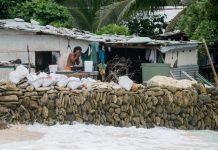The coronavirus disease (COVID-19) pandemic is threatening Asia and the Pacific’s progress toward critical targets under the Sustainable Development Goals (SDGs), according to a new report by the Asian Development Bank (ADB).
The pandemic pushed an estimated 75 million to 80 million more people in developing Asia1 into extreme poverty as of last year, compared with what would have happened without COVID-19, according to Key Indicators for Asia and the Pacific 2021, released today. Assuming that the pandemic has increased inequality, the relative rise in extreme poverty—defined as living on less than US
$1.90 a day—may be even greater. Progress has also stalled in areas such as hunger, health, and education, where earlier achievements across the region had been significant, albeit uneven.
Key Indicators presents comprehensive economic, financial, social, and environmental statistics for ADB’s 49 regional members. According to the report, about 203 million people or 5.2% of developing Asia’s population lived in extreme poverty as of 2017. Without COVID-19, that number would have declined to an estimated 2.6% in 2020.
“Asia and the Pacific has made impressive strides, but COVID-19 has revealed social and economic fault lines that may weaken the region’s sustainable and inclusive development,” said ADB Chief Economist Yasuyuki Sawada. “To achieve the 2030 Sustainable Development Goals, decision makers need to harness high-quality and timely data as a guide for actions to ensure that the recovery leaves no one behind—especially the poor and vulnerable.”
Asia and the Pacific’s economy has grown at a robust pace in recent years and contributed as much as 35% to global gross domestic product (GDP)—in current US dollars—in 2019. But COVID-19 took a toll just when weaker domestic investment and slowing global trade and economic activity were starting to challenge this momentum. Among reporting economies in Asia and the Pacific, only about 1 in 4 posted GDP growth last year. The region lost about 8% of work hours due to mobility restrictions, deeply affecting poorer households and workers in the informal economy.
The Key Indicators report includes a special supplement introducing a practical framework for measuring the digital economy and its growing role in modern life, which has been particularly evident during the COVID-19 pandemic.
Key Indicators 2021 also presents:
*The status of SDG indicators in Asia and the Pacific;
*Regional trends and tables, including indicators across eight themes—people; economy and output; money, finance, and prices; globalisation; transport and communications; energy and electricity; environment; and government and governance;
*An analysis of the pandemic’s impact on global value chains and their role as both a dampener and amplifier of shocks; and
*Updated individual country tables for the 49 regional members of ADB.
Along with the report launch, ADB has updated its Key Indicators Database, which offers access to statistical indicators going back to the year 2000, via a user-friendly and accessible interface.
ADB is committed to achieving a prosperous, inclusive, resilient, and sustainable Asia and the Pacific, while sustaining its efforts to eradicate extreme poverty. Established in 1966, it is owned by 68 members—49 from the region.
SOURCE: ADB/PACNEWS















